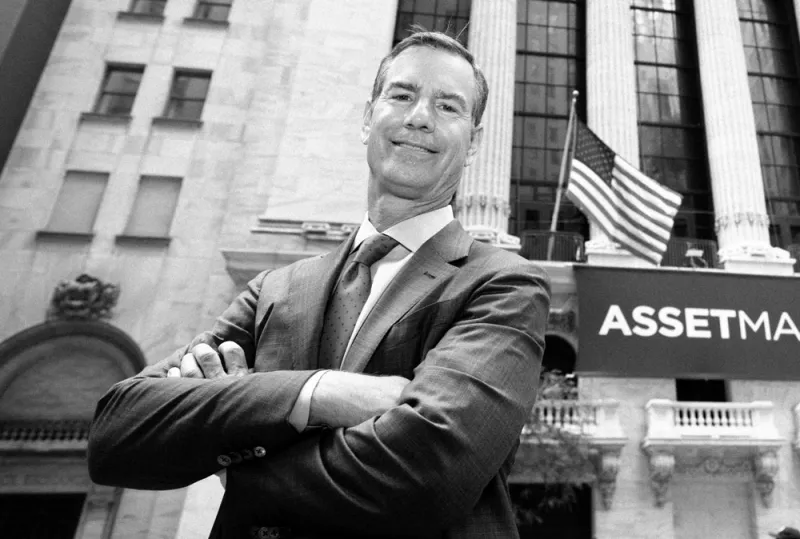Charles Goldman is not a regular speaker on the industry conference circuit or a recurring source in news articles. Perhaps he should be.
The president and CEO of AssetMark (NYSE: AMK), the turnkey asset management platform (TAMP) that went public in July, might know the wealth management business as well as anyone.
He sits on the boards of Personal Capital and Mercer Advisors. He was previously the president of Fidelity Clearing & Custody Solutions. During a stint at Charles Schwab, he was a member of the executive committee and served as the head of Schwab Institutional and head of Strategy, M&A and Venture Capital. Goldman has also been a board member of the Certified Financial Planner Board of Standards, or CFP Board.
Now at AssetMark, which sports a $1.8 billion market capitalization, Goldman is still on a mission to help advisors who refuse to outsource investment management, even though many are ill-equipped for the task.
In an interview with RIA Intel, he argues that advisors spend time on the wrong things and discussed the mystique of sell-side share price targets.
The mountaineer and avid backcountry skier also insisted he’s not a thrill-seeker. So, what draws him to those dangers? Read on.
What are you observing in the industry and what do advisors need to know?
I think that the space is changing dramatically, and I always start with the consumer. Investor needs are changing, and the needs are becoming increasingly complex and personalized. That change is happening pretty quickly, and it's one that I hope advisors are paying attention to.
Do you think that advisors are paying enough attention?
There's still a long way to go. Advisors are still spending time on the wrong things. Spending their time doing a lot of money management, picking stocks, things that, frankly, others do way better than they do.
Also, I was recently talking to one of the largest RIAs in the country about how too many advisors are calling themselves chief technology officers, chief risk officers, chief compliance officers or chief security officer. We all know that most advisors don't have the skills to do those jobs, nor want to do those jobs.
What do investors and others get and not get about TAMPs and AssetMark?
We just went public and spoke to what felt like hundreds of investors. I was surprised at how many understood the wealth management space, including the market size, market dynamics, and independent advice. They also understand that the market is very fragmented. There's no winner take all or monopoly kind of network scale answer here. But there's going to be lots of winners and lots of experimentation and value creation in the broader wealth market.
And what about TAMPs in general?
The thing that people don't see is the phenomena of outsourcing and powering the end advisor. A lot of industry watchers say, "Okay, there're advisors out there, and they fall into two buckets. One is the wirehouse, and the wirehouse provides them with everything. The other’s independent, and the independent advisor does everything." Neither's really true. The independents are looking for providers to help leverage and scale their business. That's what makes the independent space possible. Others can scale the independent advisors and that's always been the case.
What distinguishes AssetMark?
We're actually quite different than all or most other TAMPs. Most are proprietary asset management solutions. So the traditional TAMP model had the TAMP managing money their own way. We do some proprietary asset management, but for the vast majority of solutions we offer third-parties we do deep due diligence on and curate. So, we've created an investment framework called Investing Evolved, which allows advisors to understand how each piece fits together to solve specific client needs. And that is quite unique in the space. No one really does it the way we do it, and it is quite differentiated.
You have made it clear that there are a lot of subscale TAMPs in business, and many opportunities for acquisitions. But to what end? Acquisitions demand an end goal.
Scale is important because all providers in our space are looking to drive down the cost of investing and the cost of serving those clients, serving end investors. We do that by bringing the cost of investing down. We invest in technology so advisors don't have to do that, and make sure that the technology's fully integrated and offers the full set of capabilities an advisor needs to run their practice.
Those two things require size. That enables you to spread costs over more accounts, more dollars, more whatever, so it lowers unit cost. And it gives you the ability to develop intellectual capital around practice management, and deliver that at scale.
What types of services is AssetMark interested in adding? And at what cost?
When we do a consolidating acquisition, we can pay a ridiculous multiple to the seller. If they're not making any money, it's infinity, right? The multiple that the seller gets is not important to us. What’s important is the multiple that our shareholders get.
The problem with the capability side is, we don't see it that way. It's very difficult to add a capability that you don't have today, that's in another business with another revenue stream, with a different set of advisors or clients, or whatever that client mix may be, and figure out how to drive that multiple so it's accretive for shareholders. That's been a big challenge for us in any of these deals. We haven't seen one that does that, that it's worth taking on the risk of a separate line of business.
Or, that separate line of business isn't that scale, so it's not like you're really buying a separate line of business, you're buying a hobby, and that doesn't really make sense, either. Economically, does a business have to be value added? You have to make it accretive in some way. It has to have a growth trajectory in a client segment that we want to be in and be at some level of scale for it to work, and we just haven't seen that yet.
I remember you talking about the roadshow leading up to the IPO in the first earnings call. What was that process like and how has it helped the company?
Being in the independent advice space and having all the transparency of a public company is a nice benefit for our advisors and their clients. As a private company, we tried to deliver that transparency, and I think we were quite successful at our key client meetings, but this really makes it quite visible for advisors and their investors. And then, back to the M&A story, having a public currency allows us much more access to capital in the event that there's opportunities out there to buy a good asset. So, being public is really helpful for that.
Once you're under the close scrutiny of public markets, is it possible to separate that from making decisions, especially when you're talking about making large acquisitions?
Let me split those two things up. Being a public company, especially one where we have a large shareholder, and management owns a lot of the business, none of us are focused on the daily trading of the stock. I couldn't explain to you how a few hundred thousand shares changes the stock price by 10% or 5%, or whatever, in a day. It makes no sense at all. But over time, the market does value businesses quite well, and our focus is over time.
What we try to do is create value over the short, medium, and long term. And particularly focused on the medium term, where most value is created. So, I don't know. I think this idea that you're going to focus on the quarterly stock price, or the daily stock price, I don't know an executive that does that. I just think that's very shortsighted and a mistake.
You do raise a good point, though, about M&A. And we haven't done the kind of M&A where we're offering stock. We'll cross that bridge when we get to it, if that's an issue for us.
You’re on the board of the American Mountain Guide Association. Is that a hobby?
The AMGA is the CFP board for mountain guides. So, it's exactly the CFP board, which I used to be on. The CFP board, certified financial planners, creates the testing and the requirements, and that's exactly what the AMGA is, except for mountain guides.
I have a belief that education and certification is really helpful to consumers when they're making consumer decisions, whether it's about investing or getting a guide to do something that's empirically dangerous. They call it objective hazard in climbing. I am a rock climber, though not a very good one, and a skier, and do a fair amount of mountaineering. I live in Boulder, Colorado. I really love that stuff. Being part of that community is not only a nice difference from what I do in my day job, but allows me to give back to a part of the world I care about a lot.
What draws you to do that?
There's something incredibly beautiful and calming about being in remote places in the mountains. I find it cleansing for – and I hate to say this – my soul. I find it deeply enriching to be in those remote places, away from civilization, with colleagues and friends.
The other part is the challenge of it. A lot of people think that mountaineering is thrill-seeking. It's anything but. It's how do you go to these remote and objectively hazardous places and mitigate risk? How do you do these things as safely as conceivably possible? I love the application of expertise in places where you can't exactly predict things, which is like life. I think that's really cool.
The last part for me is the physical nature of it. In my day job, I have a standing desk, but am often sitting. Being out and moving is human. I like to be out and moving.
Do you have a favorite place to explore, or something on the bucket list?
I live in Colorado, so I love the mountains and rocks. I also love skiing in the backcountry of Canada. It's just an incredibly beautiful and relatively accessible place. Per your bucket list question, I've never done the Matterhorn, and would like to do that with my son.
Anything you’d like to see change about the industry?
I hope that, as an industry, we can all deliver a standard of care where the advisor puts the investor's needs ahead of their own, and has the duty to disclose clearly any conflicts of interest that exist. And I know we could improve on the conflict disclosure, and we should, but that standard of care is what RIAs have been delivering for a long time.






